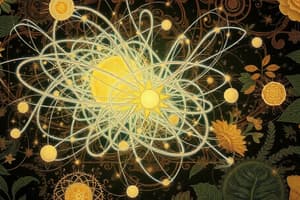Podcast
Questions and Answers
What is the definition of matter?
What is the definition of matter?
Matter is defined as anything that has mass and takes up space.
What are the states of matter?
What are the states of matter?
The states of matter are solid, liquid, gas, and plasma.
What is the difference between speed and velocity?
What is the difference between speed and velocity?
Speed is a scalar quantity that measures the rate of motion, while velocity is a vector quantity that measures the rate and direction of motion.
What is the relationship between matter and energy?
What is the relationship between matter and energy?
Explain Newton's first law of motion.
Explain Newton's first law of motion.
How does friction affect motion?
How does friction affect motion?
Flashcards are hidden until you start studying
Study Notes
Definition of Matter
- Matter is anything that has mass and occupies space.
- It exists in various forms and is composed of atoms and molecules.
States of Matter
- Solid: Defined shape and volume; particles are closely packed and vibrate in place.
- Liquid: Defined volume but takes the shape of its container; particles are close but can flow past one another.
- Gas: No defined shape or volume; particles are far apart and move freely.
- Plasma: High-energy state; consists of ionized gases and conducts electricity, found in stars and fluorescent lights.
Difference between Speed and Velocity
- Speed: A scalar quantity that refers to how fast an object is moving; calculated as distance divided by time.
- Velocity: A vector quantity that includes both speed and direction; indicates how fast and in which direction an object is moving.
Relationship Between Matter and Energy
- Matter can be converted into energy and vice versa, as described by Einstein's equation E=mc².
- Energy is necessary for matter to change states, such as solid to liquid (melting) or liquid to gas (evaporation).
Newton's First Law of Motion
- An object at rest remains at rest, and an object in motion continues in motion with the same speed and direction unless acted upon by a net external force.
- This law describes the concept of inertia, the tendency of an object to resist changes in its state of motion.
Effect of Friction on Motion
- Friction is a force that opposes the motion between two surfaces in contact.
- It affects acceleration and can cause objects to slow down, stop, or change direction; it can also generate heat.
Studying That Suits You
Use AI to generate personalized quizzes and flashcards to suit your learning preferences.



